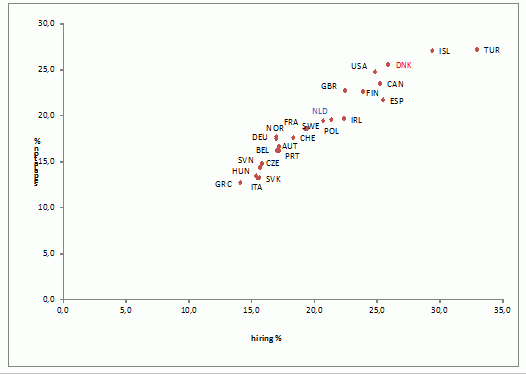The Danish “flexicurity” model has achieved outstanding labour-market performance. The model is best characterised by a triangle. It combines flexible hiring and firing with a generous social safety net and an extensive system of activation policies. The Danish model has resulted in low (long-term) unemployment rates and the high job flows have led to high perceived job security (Eurobarometer 2010).
As expected, at the onset of the crisis Denmark’s unemployment rate rose sharply. The question then is whether unemployment will fall when economic growth recovers. In this column we contrast the Danish flexicurity with the Netherlands and Germany, two countries with strict employment protection, but with a fairly comparable economic structure. We conclude that a high level of job creation and an effective activation policy are essential for the financial viability of the Danish system.
Danish institutions: A triangle
The employment protection constitutes the first corner of the triangle. For firms in Denmark, it is relatively easy to shed employees. Not only notice periods and severance payments are limited, also procedural inconveniences are limited. The employment protection legislation index of the OECD for regular contracts is only 1.5. The Netherlands and Germany, countries with employment protection legislation, have an index of 2.7 and 2.9 respectively. The underlying reason for the low employment protection can be found in the economic structure. Of old, there are many small firms for which it is burdensome and costly to have strict employment protection.
The social safety net forms the second corner of the triangle. The safety net consists of unemployment insurance and social assistance. Unemployment insurance is voluntary and half of Danish workers participate in one of these insurance funds. The unemployment-insurance funds are subsidised and on the margin fully when unemployment increases (unless at very low levels). At first sight, the unemployment benefit seems to be quite generous, namely 90% of the previous wage. However, there is a maximum of €2,000 per month. Normally, the Danish unemployment insurance is characterised as generous, but this is true for low-income groups only. The maximum duration during the recession is 4 years (from 2011 onwards 2 years) and people are only eligible by working at least 6 months within the last 36 months. After the unemployment insurance period, employees can apply for social assistance. Eligibility depends on age, marital status, and is also means-tested.
Activation policies accomplish the third corner of the triangle. The high unemployment benefit reduces search incentives. A high level of activation is therefore essential to combat moral hazard and maintain search incentives. Especially young unemployed workers receive an activation offer quickly; within three months after becoming unemployed. An important characteristic of the Danish activation policy is that the activation increases with the duration in unemployment. There is also interdependence with the social safety net. Before the unemployment benefit ends, the activation is intensified in terms of full-time activation. The activation itself can be offered in many forms - from short counselling and assessment programmes to job training and wage-subsidised jobs.
How does Denmark compare internationally?
Flexibility in hiring and firing rules together with effective activation policies lead to high labour-market dynamics. Hiring and separations are clearly higher than in the Netherlands and Germany, and meet the high level of the US (see Figure 1). Many Danish workers experience a period of unemployment, but in most cases only for a short period. The average unemployment duration is 4 months. On the contrary, in the Netherlands and Germany, the average unemployment duration was 24 months and 19 months respectively (OECD.stat). The same picture emerges when looking at the share of long-term unemployment which was twice as high in the Netherlands and Germany as in Denmark.
Figure 1. Hiring and separations, OECD Countries, 2000-2007
Datasource: OECD Employment Outlook, 2010
Labour-market responses to the great recession
In Denmark, GDP growth fell from 3.4% in 2006 to -5.2% in 2009. The fall in GDP is deeper than that in the Netherlands (from 3.4% to -3.9%) and somewhat less deep than that in Germany (from 3.4% to -3.9%) (OECD.stat). On average, European OECD-countries experience a smaller decline (from 3.5% to -4.0%). As is common for a flexible labour market with low firing costs, the Danish immediate employment reaction was severe. Interestingly, the margin of adjustment in Denmark has mainly been in the extensive margin, the number of persons employed. In countries with strict employment protection legislation such as the Netherlands and Germany, the adjustment has mainly been in the intensive margin, the number of hours (see Figure 2).
Figure 2. Decomposition employment adjustments in persons versus hours
From an international perspective, the initial employment response in Denmark was relatively sharp and sharper than would have been expected by the decline in output (see Figure 3). This may have been caused by the hoarding of labour prior to the crisis. The unemployment rate was only 3.3% in 2008 compared with an average 7.1% in the European OECD-countries (OECD.stat). In reaction, Danish firms attracted many workers, due to which employment growth exceeded production growth. Firms in the Netherlands and Germany did the same. At the onset of the crisis the strategies of Germany and The Netherlands, however, diverged from that of Denmark. In Denmark, firms immediately fired workers and the initial employment response was larger than would be expected from the fall in output. In the Netherlands the employment response was relatively mild due to continued hoarding of labour. The reason for this strategy is that Dutch firms foresee a shortage of labour and recruitment problems in the near future (Bosch and Euwals 2010). In Germany, generous working-time arrangements made labour hoarding possible and contributed to the mild unemployment response (Möller 2010). The different reaction in Denmark suggests that the high turnover rates not only make workers more confident in finding jobs, but also firms more confident in finding workers when the economy recovers.
Figure 3. Unemployment rates: Denmark, Germany, The Netherlands and EU-15 (January 1983 - January 2011)
Challenges for Denmark
As expected for a country with low employment protection, the immediate unemployment response in Denmark was severe. At the same time, it is expected that its employment will rise as soon as the economy recovers. So far, however, Denmark’s unemployment rate is still rising while in other countries such as the Netherlands and Germany unemployment rates are already declining (Figure 3).
The real question then is whether unemployment will remain high leading to persistent unemployment. After two decades of high and persistent unemployment, the main focus in the mid-90s was analysing the causes and recommending policies to tackle such problems (Elmeskov et al. 1998). In that study, Denmark stands out as one of the successful countries. A large part of its success was attributed to labour-market reforms implemented before the great recession. But how is Denmark’s model coping with the crisis today?
The financial viability of the Danish system requires two things: an effective activation policy and high job creation. A recent study indicates that the effectiveness of activation programmes has declined during the current crisis (Andersen 2011). This is partly due to the increase in the number and the composition of participants, as well as the lower number of vacancies. The increase in inflow puts pressure on the quality of activation. Furthermore, due to longer unemployment durations, those who would normally find a job quickly are now also getting an activation offer. For them, a high level of activation results in a high deadweight loss. Finally, there are fewer vacancies and job finding rates are consequently lower. Consequently, the employment outcomes of those in activation have deteriorated. Whereas at the beginning of 2007 nearly 55% found a job after 12 months, only 30% found a job at the beginning of 2009. As expected, the chances of an unemployed person finding a job at the peak prior to the crisis (2008-2) are lower than those in the midst of the recession (2009-3). Still, workers that lost jobs in the midst of the recession found employment rather soon; 60% after 13 weeks and 80% after 26 weeks (Andersen 2011).
Conclusion
The unemployment reaction of Denmark to the Great Recession has been severe, but is in line with a flexible labour-market model and the unemployment rate is still below OECD average. And though job-finding rates are lower than before, they are still substantial and most unemployment spells are short, thus preventing unemployment from becoming persistent. Furthermore, Danish workers are still convinced of finding a job if they are laid off (Eurobarometer 2010). The big challenge will be whether activation – an essential part of the Danish model – will remain effective and whether job creation is going to be high enough. Hence, notwithstanding the relatively high unemployment reaction today, upcoming years will tell whether the Danish flexicurity model remains an example for other countries.
References
Andersen, Torben M (2011), “A flexicurity labour market in the great recession – the case of Denmark”, paper presented at the CPB-ROA conference on flexibility of the labour market.
Bosch, Nicole M and Rob Euwals (2010), “Gevolgen crisis voor arbeidsmarkt vallen vooralsnog mee”, in Koninklijke Vereniging van Staatshuishoudkunde, KVS Jaarboek 2009/2010, Den Haag: 67-78.
Elmeskov, Jorgen, John P Martin and Stefano Scarpetta (1998), “Key Lessons for Labour Market Reforms: Evidence from OECD countries’experiences”, Swedish Economic Policy Review, 5:205-252.
Eurobarometer (2010), Flash Eurobarometer - Monitoring the social impact of the crisis: public perceptions in the European Union, Flash EB Series, 289.
Möller, Joachim (2010), “The German labour market response in the world recession – de-mystifying a miracle”, ZAF, 42:325-336.
OECD.stat, OECD Statistical Database.







